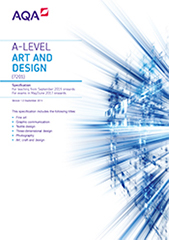3.5 Graphic communication
Students should be introduced to a variety of experiences that explore a range of graphic communication media, processes and techniques. They should be made aware of both traditional and new media.
Students should explore the use of drawing for different purposes, using a variety of methods and media on a variety of scales. Students may use sketchbooks/workbooks/journals to underpin their work where appropriate.
Students should explore relevant images, artefacts and resources relating to a range of art, craft and design, from the past and from recent times, including European and non-European examples. This should be integral to the investigating and making processes. Students' responses to these examples must be shown through practical and critical activities that demonstrate their understanding of different styles, genres and traditions.
Students should be aware of the four assessment objectives to be demonstrated in the context of the content and skills presented. They should be aware of the importance of process as well as product.
Areas of study
Students are required to work in one or more area(s) of graphic communication, such as those listed below. They may explore overlapping areas and combinations of areas:
- interactive media (including web, app and game design)
- advertising
- packaging design
- design for print
- illustration
- communication graphics
- branding
- multimedia
- motion graphics
- design for film and television.
Skills and techniques
Students will be expected to demonstrate skills, as defined in Overarching knowledge, understanding and skills, in the context of their chosen area(s) of graphic communication. Students will be required to demonstrate skills in all of the following:
- understanding of meaning, function, style, scale, colour and content in relation to the chosen area(s) of graphic communication
- awareness of intended audience or purpose for their chosen area(s) of graphic communication
- ability to respond to an issue, concept or idea, working to a brief or answering a need in the chosen area(s) of graphic communication
- appreciation of the relationship of form and function and, where applicable, the constraints of working to a brief
- appreciation of the appropriate use of typography (which could include hand lettering and calligraphy)
- understanding of a variety of materials and genres appropriate to their chosen area(s) of graphic communication.
Knowledge and understanding
Students must show knowledge and understanding of:
- relevant materials, processes, technologies and resources
- how ideas, feelings and meanings can be conveyed and interpreted in images and artefacts created in the chosen area(s) of graphic communication
- historical and contemporary developments and different styles and genres
- how images and artefacts relate to social, environmental, cultural and/or ethical contexts, and to the time and place in which they were created
- continuity and change in different styles, genres and traditions relevant to graphic communication
- a working vocabulary and specialist terminology that is relevant to their chosen area(s) of graphic communication.
